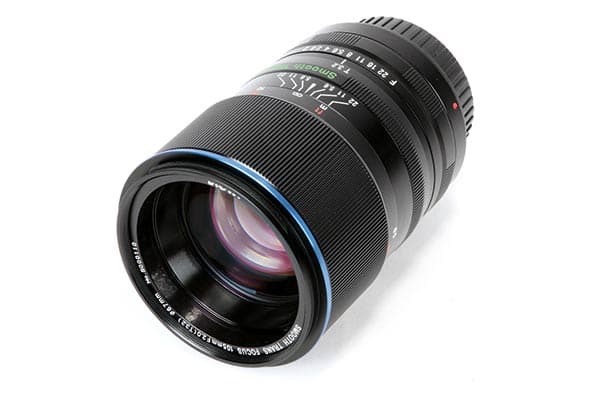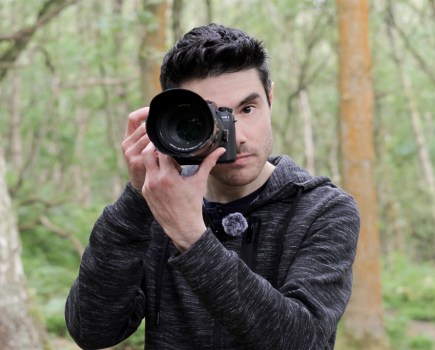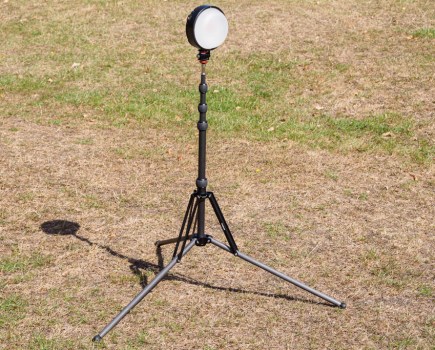Laowa 105mm f/2 (T3.2) STF – Introduction

We’re always on the lookout for new and intriguing lenses to review, and one that caught our attention when it was announced earlier this year was the Laowa 105mm f/2 (T3.2) STF. Designed as a medium telephoto lens specifically for DSLR cameras with a full-frame sensor, it’s primarily intended for portraiture and is rather niche in that it’s one of only a few lenses to feature an apodization element, which promises to deliver superior bokeh rendering and pin-sharp images.
For those wondering what STF stands for in the lens name, it refers to Smooth Trans Focus – a lens design that’s associated with producing a high level of sharpness at the plane of focus, and at the same time gradually melting away to form a soft, natural and beautifully diffused out-of-focus rendition. There are very few lenses that feature an apodization element – the only others that spring to mind are the Sony 135mm f/2.8 (T4.5) STF and the Fujifilm Fujinon XF 56mm f/1.2 R APD. Unlike the Fuji lens, the Laowa is manual focus only: just like the 135mm f/2.8 (T4.5) STF Sony produces for the A-mount.
Laowa 105mm f/2 (T3.2) STF – Features

The lens’s Smooth Trans Focus design renders out-of-focus highlights beautifully
There’s a lot to learn about the optical construction of this lens. Starting with the apodization element, this is inserted next to the diaphragm, and designed to transmit all of the light that’s directed through the centre of the aperture, but reduce its intensity gradually towards the periphery. In layman’s terms, the apodization element resembles a circular graduated ND filter that becomes darker towards the outer edge – and it’s this graduation that’s said to help produce smooth tonal transitions and creamy defocused backgrounds. The lens is also interesting in the way it has two separate diaphragms, both of which are controlled manually via separate rings on the barrel.
The 14-bladed circular aperture, which is located closest to the front of the lens, provides users with the ability to produce the smoothest bokeh possible. With its de-clicked aperture ring, it can actually provide videographers with a silent way of controlling the light passing through the lens, and the transmission value (the amount of light that reaches the sensor) is marked in T stops from T3.2 to T8. The eight-bladed aperture that’s located behind the 14-blade circular aperture is intended for photographers to control the aperture opening (f-number) and the depth of field in the usual way. However, this ring does click between stops. Note that when either one or the other diaphragm is used, the unused one should always be left wide open. For example, if the 14-blade circular aperture is set to f/5.6 or f/8, the eight-blade aperture should be set to f/2. Likewise, if the eight-bladed aperture is set to f/11, the 14-blade circular aperture should be set to T3.2.

Aperture control aside, the lens arranges 11 elements in eight groups and includes one HR (High Refractive Index) element, three LD (Low Dispersion) elements as well as two floating elements, not forgetting the apodization element. With a complex internal construction, it’s a heavy lens for its size and weighs 745g on the scales. Other features to note include its 90cm minimum focusing distance and its 67mm thread for attaching screw-in filters and adapters. It’s currently available for Canon EF, Nikon F, Pentax K and Sony A-mount DSLRs, as well as Sony E-mount CSCs, including the Alpha 7 series, and is priced at £649.
Laowa 105mm f/2 (T3.2) STF – Build and handling

The lens is presented in a smart box, and you instantly appreciate how solid and well made it is when you pick it up for the first time. The lens barrel is manufactured from metal to give it a robust and durable feel in the hand, and it’s good to see all the aperture and focal-length markings engraved into the metal as opposed to being printed on top. As to be expected from a manual-focus lens, there is no electronic communication with the camera, and as such the anodized metal mount at the rear doesn’t have any metal contacts to translate aperture information to the camera’s EXIF data. If you’d like to keep a record of what settings you use for each shot, you’ll need to put pen to paper.
The accuracy of focusing relies a lot on how good your eyes are at judging what’s in and out of focus. If you’re not in a hurry and have time to carefully compose your shot, you’ll want to engage your camera’s live view mode and magnify the point of focus on-screen before fine-tuning the focus using the large manual-focus ring. This is very finely grooved, just like the ring that’s located behind it to control the 14-blade aperture. The manual-focus ring offers a pleasing and consistently fluid motion across its range, operating between its 0.9m minimum focus distance and infinity with a 270° turn. This long rotation is very effective for precise focusing adjustments, and as a lens to operate from behind the camera it reminded me of using a Samyang lens.

The maximum aperture (f/2) is effective at isolating subjects from busy and distracting backgrounds
As mentioned, the 14-blade aperture ring is de-clicked and operates across its T3.2-T8 range effortlessly. It notches into place at its widest setting and it has a different feel to the eight-bladed aperture ring behind. In use, I found this helped identify which aperture ring was which and prevented me having to pull my eye away from the viewfinder to check.
Overall, I found it hard to pick fault with the build quality or the way the lens handles when attached to a full-frame DSLR. The only slight disappointment is the supplied lens hood, which is made from plastic and doesn’t share the same resilient, robust build quality as the lens itself. It didn’t lock particularly well on our review sample when it was attached, either. It looks and feels like an afterthought on what is otherwise a well-made and solid lens.
Laowa 105mm f/2 (T3.2) STF – Image quality

The lens produces very sharp results at the point of focus, but a precise focusing technique is required
The true area of interest of this lens lies in its bokeh and out-of-focus qualities. Thanks to its long focal length and large aperture it’s possible to create beautiful bokeh in out-of-focus areas. Bokeh is rendered in a wonderfully circular fashion, and doesn’t show any outlining towards the edge at f/2, whereas stopping down to f/2.8 and f/4 sees the outlining effect become slightly more pronounced around the perimeter of highlight discs. Switching between the 14-bladed diaphragm and the eight-bladed aperture before comparing the results side-by-side revealed a subtle difference. To create the most satisfying circular bokeh users should experiment with both diaphragms, but take special notice that both rings should not be used together.
A study of our lab results shows the lens produces a reasonable level of sharpness in the centre at f/2, with the corners appearing only slightly softer. Centre sharpness improves at f/2.8, and peaks at around f/4-5.6. It remains high at f/16, but sharpness drops off a little at f/22 due to the inevitable softening effect of diffraction.

Corner sharpness is relatively unimportant with such a specialised portrait lens, where the subject is usually going to be composed towards the centre of the frame. It improves gradually as the lens is stopped down, peaking at f/8, but then tails off beyond f/16. The sweet spot between centre and corner sharpness on this lens is therefore found between f/5.6 and f/8. To create the shallowest depth of field, users will be tempted to use its maximum aperture, but I found some of my sharpest and best results were captured at f/2.8.
A study of our uncorrected raw files reveals corner shading at wide apertures. We measured the corners to be approximately 1.2EV darker than the centre of the frame at f/2, reducing to 0.6EV at f/4. Stop the lens down further and you’ll quickly find corner shading disappears and no longer makes itself known in real-world images.
Medium telephoto primes are well known for controlling distortion extremely well, and this lens is no different. Our distortion chart shows just how well the lens controls curvilinear distortion, rendering straight horizontal and vertical lines right towards the edge of the frame. Rigorous testing of the lens in high-contrast conditions also revealed how well it controls chromatic aberrations. Looking at raw files with all corrections turned off showed barely any hint of fringing along high-contrast edges, even when images were studied at 100% magnification in Adobe Photoshop.
Laowa 105mm f/2 (T3.2) STF – Testing
Resolution

Solid line: 105mm centre
Dotted line: 105mm corner
Our Applied Imaging tests tell us the centre is only slightly sharper than the corner when the lens is used at f/2. Centre sharpness improves as the lens is closed down towards f/4 and remains high up to f/16. Diffraction affects the level of sharpness at f/22, hence the drop on the graph. Corner sharpness improves when the lens is stopped down to f/8. Like the centre sharpness, though, it drops off at f/22. The sweet spot between centre and edge sharpness is located between f/5.6 and f/8.
Shading

f/2

f/4
Using the lens at its maximum aperture introduces corner shading at the edges, with corners appearing approximately 1.2EV darker than the centre of the image. I found this vignetting to be rather tasteful and it encourages the viewer’s eye towards the centre of the image. Stopping the lens down to f/4 sees corners appear 0.6EV darker than the centre.
Curvilinear distortion

SMIA TV = -0.1%
Telephoto prime lenses have a reputation for controlling curvilinear distortion better than zooms. This Laowa optic rendered the horizontal and vertical lines perfectly straight on our test chart, saving us time having to correct for any barrel or pincushion distortion in our software.
Laowa 105mm f/2 (T3.2) STF – Verdict

The Laowa 105mm f/2 (T3.2) STF is a niche lens that won’t appeal to everyone. The fact that it’s manual focus only lends it to subjects that are static, and with those that move unpredictably it’s unlikely you’ll find focus fast enough using this lens. But modern DSLRs aren’t best-suited to manual focus, so it would be more enjoyable to use with a mirrorless camera sporting better manual focusing aids.
The silky background blur this lens is capable of producing at wide apertures is particularly pleasing to the eye and helps to create a distinct separation between your subject and what lies in front or behind. Closing the lens down to f/2.8 produces impressive sharpness in the centre and the lack of chromatic aberration and distortion must be commended. The quality of its build is as good as you’d expect for the price, but it’s ultimately the quality of the bokeh and blur you’re paying for here. This lives up to our high expectations, and in the right hands can produce stunning results well suited to portraiture.









